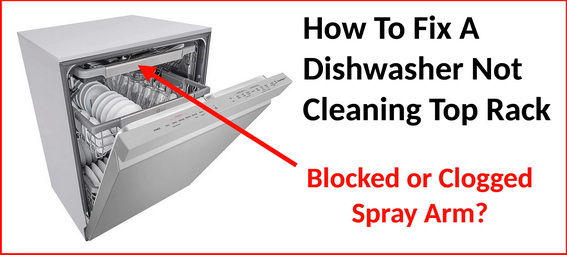Dishwasher does not clean the dishes properly, especially those placed on the top rack? This information will give you some solutions and ways to get the dishwasher to clean the top rack.

Dishwasher Not Cleaning Top Rack
Blocked or Clogged Spray Arm
A frequent cause of your dishwasher not cleaning on the top rack of a dishwasher is an obstructed or congested spray arm. The spray arm, located below the top rack, is responsible for spraying water and detergent onto the dishes.
Over time, the spray arm’s holes can become blocked by food particles, leading to insufficient water pressure and poor cleaning.
We’ll walk you through the process of unclogging a dishwasher spray arm in simple, easy-to-follow steps. This will help your dishwasher run more efficiently and ensure your dishes come out clean.
- Collect the necessary items: To get started, gather a soft cloth, toothpick or needle, and white vinegar for soaking the spray arm.
- Turn off the dishwasher: Ensure the dishwasher is off and disconnected from the power supply for safety.
- Remove the top rack: Carefully take out the top rack of the dishwasher to access the spray arm.
- Detach the spray arm: Gently remove the spray arm from its position, paying attention to how it’s attached for reassembly later.
- Soak the spray arm: Submerge the spray arm in a mixture of warm water and white vinegar for at least an hour to help dissolve any built-up debris.
- Clean the nozzles: Using a toothpick or needle, carefully remove any leftover debris from the spray arm’s nozzles to ensure proper water flow.
- Rinse and dry the spray arm: After cleaning, thoroughly rinse the spray arm under running water and use a soft cloth to dry it.
- Reattach the spray arm: Place the spray arm back in its original position, making sure it is securely attached.
- Run a test cycle: Finally, reconnect the power supply, turn on the dishwasher, and run a test cycle to ensure the spray arm is functioning correctly.
Faulty Water Inlet Valve
The water inlet valve controls the flow of water into the dishwasher. The valve may be faulty or clogged. This can lead to low water pressure. As a result, the top rack may not get cleaned properly.
Examine your dishwasher’s water inlet valve for any damage or clogs. This process involves disconnecting the dishwasher, reaching the water inlet valve, inspecting and cleaning it, and testing the appliance. Remember to exercise caution when dealing with electrical parts.
- Unplug the dishwasher: Before starting, ensure the dishwasher is disconnected from the power source.
- Locate the water inlet valve: You’ll typically find this component behind the dishwasher’s lower access panel or kick plate. Remove the panel to reveal the valve.
- Inspect the valve: Look for any signs of damage, such as cracks or leaks. If you spot any issues, consider replacing the valve.
- Check for blockages: Examine the valve’s screen for debris or mineral buildup that could obstruct water flow. If necessary, gently clean the screen using a soft brush and mild detergent.
- Reassemble the dishwasher: Once you’ve inspected and cleaned the valve, reinstall the lower access panel or kick plate.
- Test the dishwasher: Plug the dishwasher back in and run a cycle to verify that the water inlet valve is functioning correctly.
Insufficient Detergent or Rinse Aid
Using an insufficient amount of detergent or rinse aid can lead to poor cleaning results, especially on the top rack. This is because the detergent and rinse aid help to break down food particles and prevent water spots.
Ensure you are using the recommended amount of detergent and rinse aid for your dishwasher model. Check the dishwasher user manual for specific recommendations.
Dirty Filter
A dirty or clogged filter can impede the flow of water in your dishwasher, resulting in poor cleaning performance. The filter is responsible for trapping food particles and preventing them from being redeposited onto your dishes.
Remove and clean the dishwasher filter according to the manufacturer’s instructions. This should be done regularly to maintain optimal performance.
Top Rack Cleaning Tips
Loading Dishes Correctly
Organizing the dishes in your dishwasher correctly can significantly boost its cleaning ability. Ensure that dishes, especially those on the top rack, are positioned correctly and not overlapping, which can prevent water and detergent from reaching all surfaces.
Regular Maintenance
Regularly maintaining your dishwasher can help prevent top rack cleaning issues. This includes cleaning the spray arms, filter, and door seals, as well as checking the water inlet valve and hoses for any signs of damage or blockage.
Use a Dishwasher Cleaner
Using a dishwasher cleaner can help remove built-up grease, grime, and limescale from the internal components of your dishwasher, improving its overall cleaning performance.
Adjust Water Temperature
Increasing the water temperature in your dishwasher can help improve cleaning performance. Check your dishwasher’s user manual for instructions on adjusting the water temperature.
Avoid Top Rack Issues
Scrape Food Particles Off Dishes
Before loading your dishes, ensure you scrape off any large food particles. This will help prevent blockages in the spray arm and filter, improving the cleaning performance of your dishwasher.
Use a High-Quality Detergent
Using a high-quality detergent can help improve the cleaning performance of your dishwasher. Look for detergents specifically designed for dishwasher use and follow the manufacturer’s recommendations for the correct amount to use.
Regularly Inspect and Clean the Dishwasher
Regularly inspecting and cleaning your dishwasher, including the spray arms, filter, and water inlet valve, can help prevent top rack cleaning issues.
A dishwasher’s top rack cleaning issues can often be resolved by addressing common problems such as blocked spray arms, faulty water inlet valves, or insufficient detergent. Regular maintenance, proper loading, and using high-quality cleaning products can also help improve your dishwasher’s performance.



Leave a Reply